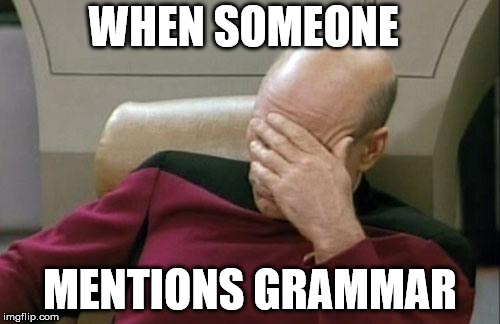
Grammar.
Grammar is the topic that people tend to bring up to me when I tell them I teach writing. As a writing teacher, I feel a bit anxious when someone mentions this word. I anticipate the following:
“Ugh, no one can write anymore.”
“I didn’t even learn grammar as a kid.”
“Some of my coworkers have terrible grammar.”
The above laments may be accompanied by sighs, nodding heads, and a shared sentiment of frustration over the state of writing instruction.
Yet, as a composition teacher, I believe that the problem of grammar instruction is incredibly messy. John Bean summarizes the mess of teaching grammar and sentence correctness in Chapter 5 of Engaging Ideas. Bean points to complaints by teachers across the disciplines that students can’t write. What teachers mean, Bean says, is that students make sentence-level errors. However, the issue of addressing error is so complex that, despite non-English faculties wishes, composition teachers cannot simply “fix” student errors with the wave of a semester-long-writing-class wand. The reasons for the lack of a quick fix are vast, as Bean reviews in his chapter on this topic.
Several issues account for the problem of teaching sentence correctness (Bean, 2011):
- The traditional teaching method of “skill and drill” exercises and red pen marks on papers has been proven to be ineffective (Braddock, Lloyd-Jones, & Schoer, 1963).
- The above teaching methods may even have a harmful effect on students since they are ineffective and eat up time that could be spent on more meaningful instruction.
- It’s unclear what we even mean when we say that someone “knows grammar.”
On the third issue, Bean writes that linguists have distinguished between different levels of grammar. Patrick Hartwell’s important study, specifically, distinguishes between these levels of grammar:
- Grammar 1: The grammar in our heads
- Grammar 2: Rules of language as discerned by linguists
- Grammar 3: Usage
- Grammar 4: School grammar
If you’re interested in learning more about these levels, check out Hartwell’s study. The gist, though, is this: a person’s ability to use language fluently is a result of Grammar 1, which we develop by being immersed in rich language environments (Bean 2011). On the other hand, the idea of “bad grammar” actually has nothing to do with grammar itself, as “bad grammar” often refers to usage that is still linguistically quite clear and understandable (Ex: “I ain’t going to class today.” – this is understandable, especially in a particular social context, but is typically considered “bad grammar”). So, when we talk about grammar, what we often mean is a person’s ability to conform to the conventions of a particular group of people in a particular context.
But does the fact that “bad grammar” isn’t always linguistically ungrammatical mean that composition teachers should ignore usage? Bean (2011) argues, and I tend to agree, that errors can harm the effectiveness of a piece of writing.
Indeed, sentence-level errors can be quite problematic from a reader’s viewpoint. One of my favorite studies is by Larry Beason (2001) called “Ethos and Error: How Business People React to Errors.” In this article, Beason shared a questionnaire with business people and then interviewed 14 participants to gather their personal reactions to different kinds of errors. To put it simply, Beason’s study suggested that different people are more or less bothered by different errors. This finding suggests two important conclusions about error: 1) Error can cause the reader to develop a negative impression of the writer, and 2) Different readers find different errors frustrating. All this is to say that when we talk about teaching sentence-correctness, we also may want to keep in mind that correctness does matter (though it matters differently to different readers).
The takeaway? Teach students to discern what counts as error and how to avoid those errors in different situations, and teach students that errors can hinder their relationship with the reader.
At least that’s my takeaway. What’s yours? How do you approach the teaching of sentence-level correctness? Should composition instructors respond to requests from outside departments to increase grammar instruction? I’d love to hear from readers in the comments below.
Wow. Really nice synthesis of these major studies, Krista. I appreciate your “takeaway” as well. Error (as well as correctness) is all about context, right? My take is that we have an ethical responsibility that goes beyond teaching students what counts as error/and how error can affect their readers’ perception of them and their writing. We also need to figure out a way to let our students know that the assessment of error has been used to uphold dominant language ideologies and identities as well.
LikeLike